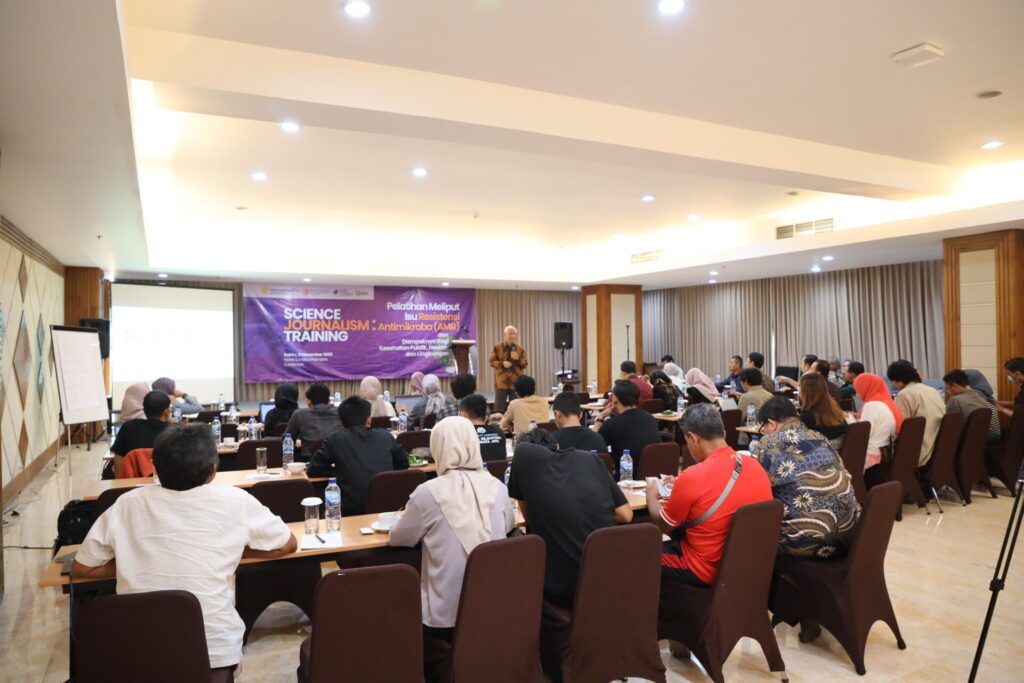Engaging Indonesian Media in the Fight against Antimicrobial Resistance

In South-East Asia, the topic of Antimicrobial resistance (AMR) is seldom covered by the Indonesian media due to a knowledge gap among journalists and editors, hindering the dissemination of critical information. To address this issue, WOAH trained more than 40 media personnel in Surabaya, Indonesia.
AMR is often referred to as a “silent pandemic”. Despite its profound consequences for human, animal, and environmental health, AMR remains largely unfamiliar to non-expert audiences. Raising awareness and advocacy are essential tools to mitigate AMR as they can lead to changing risky behaviours among different stakeholders. In this context, professionals in the field of animal health are often the target audience for information, education, and communication materials, as well as awareness-raising activities. Additionally, Veterinary Services regularly advocate for the implementation of guidelines to promote the responsible use of antimicrobials targeting farming communities, veterinarians, and pharmacists. Yet, it is uncommon for trustworthy information on AMR to successfully reach a wider audience, meaning consumers or pet owners.
Low Visibility of AMR in Mass Media
Communicating about AMR in mass media poses several challenges in South-East Asia due to the prevalence of other pressing topics, such as animal diseases, that capture more attention. For instance, African swine fever and foot and mouth disease have serious consequences on international trade and local economies, while rabies can lead to human deaths. Journalists can easily work on stories about these topics by selecting different approaches to attract a large audience. However, AMR consequences do not occur following a particular event or outbreak that is traceable but are rather the result of constant bad practices in different sectors, which could be considered less newsworthy.
Engaging the media is essential for raising awareness since articles, interviews and other content formats can shape public perception, policies, and stakeholder engagement on a particular issue. Yet, in South-East Asia, journalists face challenges in developing expertise on complex issues such as AMR due to time constraints. Additionally, limited knowledge, competing interests and editorial choices also restrict their opportunities to conduct research on AMR.
Addressing the Knowledge Gap in Indonesian Media
To address these challenges and increase the level of public awareness on AMR, WOAH conducted media engagement activities in Indonesia in May 2023. Around 40 journalists participated in the first edition of the media training organised in Jakarta in the framework of the Multi-Partner Trust Fund (MPTF) project and in cooperation with the largest Indonesian association of independent journalists (AJI). Nearly all the participants admitted their lack of knowledge or total unfamiliarity with what AMR entails. However, they also unanimously recognised the potential success of communicating about AMR and, shortly after the training, published articles related to AMR in mass media.
A second training was organised in Surabaya, the main city of East-Java Province of Indonesia, under the support of UK Fleming Fund in order to extend the training to journalists based at provincial level. These professionals usually face several challenges in terms of access to information and resources, which are barriers to prioritise science communications. Due to these constraints, AMR was not adequately covered or rather not covered at all in East-Java. Additionally, several poultry farms are located in this province, making it a relevant choice to engage local farmers. The socio-economic context could also contribute to raising interest in AMR since the consumption of chicken is very high in this area.

Scientific Journalism: A Rigorous Approach to fighting AMR in Indonesia
The second training was attended by 42 journalists, with diverse roles in the media from reporters to managing directors, content writers, and editors. The training provided an overview of the current AMR situation in Indonesia and introduced the One Health approach to mitigate this global health threat. A well-known journalist addressed the methodology needed to report on science-based facts, highlighting key principles:
- Accuracy: scientific information should be conveyed without distorting the findings or misrepresenting the research
- Clarity: scientific content should be clear and comprehensible to a general audience to form their opinion
- Relevance: scientific evidence should be connected to everyday experiences to make the information more engaging
The COVID-19 pandemic was used as a case study to learn from the experience of this health crisis, when media statements in Indonesia were not always based on scientific evidence, misleading the general public. To avoid the dissemination of fake news, journalists were recommended to cross-check information by consulting academic journals, interviewing several experts and, in case of conflicting analysis, presenting the facts to allow the audience to form its own opinion.
Publication on AMR in Provincial and Local Media
The outcomes of the training were assessed to better understand how journalists benefited from this activity showing encouraging results as over 250 publications on AMR were issued in the mass media (TV, online newspapers, radio, etc.).
As highlighted by the results of this activity led by WOAH, while media engagement requires a lot of effort, it can also present great opportunities to raise awareness on responsible antimicrobial use among non-technical audiences. This will help increase the visibility of this “silent pandemic”, which is already responsible for over 4 million human deaths per year.
More information
-
Antimicrobial Resistance
